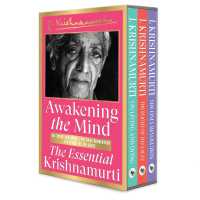Full Description
In Literary Sinitic and East AsiaReading, Professor Kin Bunkyo surveys the history of reading technologies referred to as kundoku in Japanese, hundok in Korean and xundu in Mandarin. Rendered by the translators as 'vernacular reading', these technologies were used to read Literary Sinitic through and into a wide variety of vernacular languages across diverse premodern East Asian civilizations and literary cultures. The book's editor, Ross King, prefaces the translation with an essay comparing East Asian traditions of 'vernacular reading' with typologically similar reading technologies in the Ancient Near East and calls for a shift in research focus from writing to reading, and from 'heterography' to 'heterolexia'.Translators are Marjorie Burge, Mina Hattori, Ross King, Alexey Lushchenko, and Si Nae Park.
Contents
Editors' PrefaceVernacular Reading in the Sinographic Cosmopolis and BeyondAuthor's Preface to the English EditionAcknowledgementsList of FiguresAcronyms and AbbreviationsIntroduction1 Buying Tickets at the Station2 A Ticket Gate3 Sinographic Expressions in East Asia4 "Vernacular Reading": The Kundoku Phenomenon in the Sinographic Cultural Sphere1 Reading Literary Sinitic-kundoku "Vernacular Reading" in Japan1 What Is Kundoku?2 Kundoku and Chinese Translations of Buddhist Sutras3 The Ideological Context of kundoku4 The Initial Stage of Kundoku: From the Early Nara to the Mid-Heian Periods5 Kundoku in the Period of Maturity: From the Mid-Heian to Insei Periods (ca. 10th to 12th Centuries CE)6 New Developments in Kundoku: From the Kamakura to Early Modern Periods7 Kundoku since the Meiji Period2 Vernacular Reading in East Asia1 Hundok on the Korean Peninsula2 Hundok in Silla and Kokunten in Japan3 Ideological Background of hundok on the Korean Peninsula4 Vernacular Reading Phenomena on the Periphery of China5 Vernacular Reading Phenomena in China3 Writing in Literary Sinitic: The Diverse World of Literary Sinitic in East Asia1 The World of Poetry in East Asia2 The Diversity of Literary Sinitic4 Concluding Thoughts: The East Asian Literary Sinitic Cultural Sphere1 A Diverse Range of Ways to Pronounce Sinographs2 A Diverse Range of Ways to Read Literary Sinitic3 A Diverse Range of Literary Sinitic Inscriptional Styles4 Literary Sinitic Inscriptional Style and Social Class5 East Asian Literary Sinitic Cultural Sphere5 EpilogueBibliographyIndex of Named IndividualsIndex of Texts CitedIndex and Glossary of Terms







